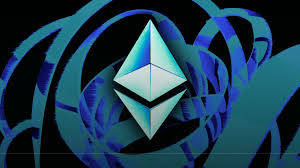Author: McKenna
Translation: TechFlow
Introduction
Between 2024 and 2025, Hyperliquid swept through the digital asset sector, finally realizing the long-awaited transformation from centralized traditional institutions to a fully permissionless, transparent, and global perpetual futures market. In a short period, Hyperliquid has become the top revenue generator in the blockchain space, surpassing other general-purpose networks, all built and driven by a small team of just 11 people. This technological achievement is truly remarkable, fully showcasing the intelligence and strength of Hyperliquid’s core team. We believe Hyperliquid is one of the most important growth stories in the digital asset space, even surpassing the massive growth trend seen in stablecoins after regulatory clarity (with the regulation of stablecoin issuers through the GENIUS Act).
Although Hyperliquid has achieved significant success, we believe it is necessary to take a step back, re-examine this thesis from the beginning, and combine it with a concrete valuation framework. In revising our argument, we will review Hyperliquid’s rise, how it has significantly eaten into the perpetual trading market share of centralized competitors, and further outline an even grander vision for the coming years—encompassing the entire financial system.
The Hyperliquid Growth Story
Perpetual Trading
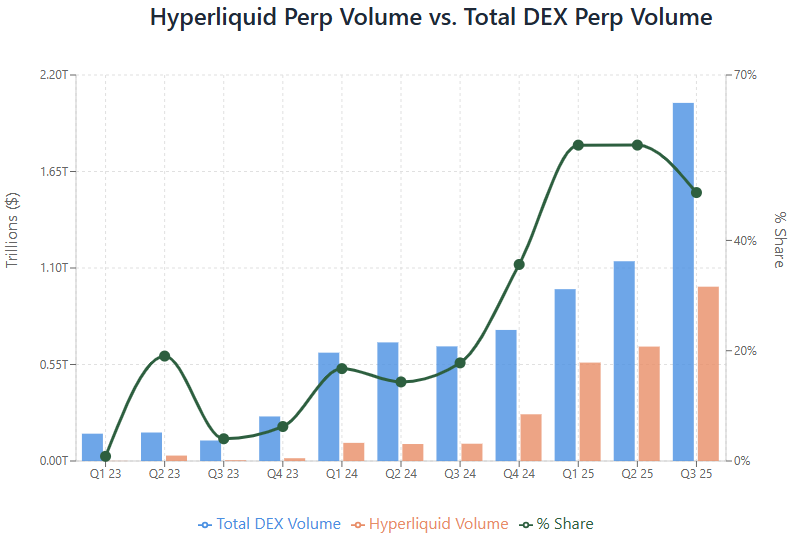
Hyperliquid Trading Volume vs Total DEX Trading Volume
Hyperliquid’s rise is mainly due to its protocol architecture, meticulously optimized for perpetual futures trading. HyperCore is the underlying trading and settlement engine of the Hyperliquid protocol, offering for the first time an off-chain experience close to centralized exchanges (CEX), with millisecond-level trade execution speed and session key implementation, allowing traders to execute orders easily without trade confirmations. Below is a brief review of all relevant perpetual futures trading statistics since the platform’s inception:
Overall, since its launch, Hyperliquid has completed $2.77 trillion in trading volume, with users executing 16.5 billion trades.
Looking at the quarter-on-quarter growth of perpetual trading volume in 2025, Hyperliquid grew by 110.72% in Q1 2025, 16.27% in Q2, and 52.25% in Q3.
In August 2025, Hyperliquid set its highest trading volume record to date, with perpetual trading volume reaching $398 billion.

Hyperliquid Perpetual Trading Volume Quarter-on-Quarter Growth
Hyperliquid vs Centralized Exchange (CEX) Competitors
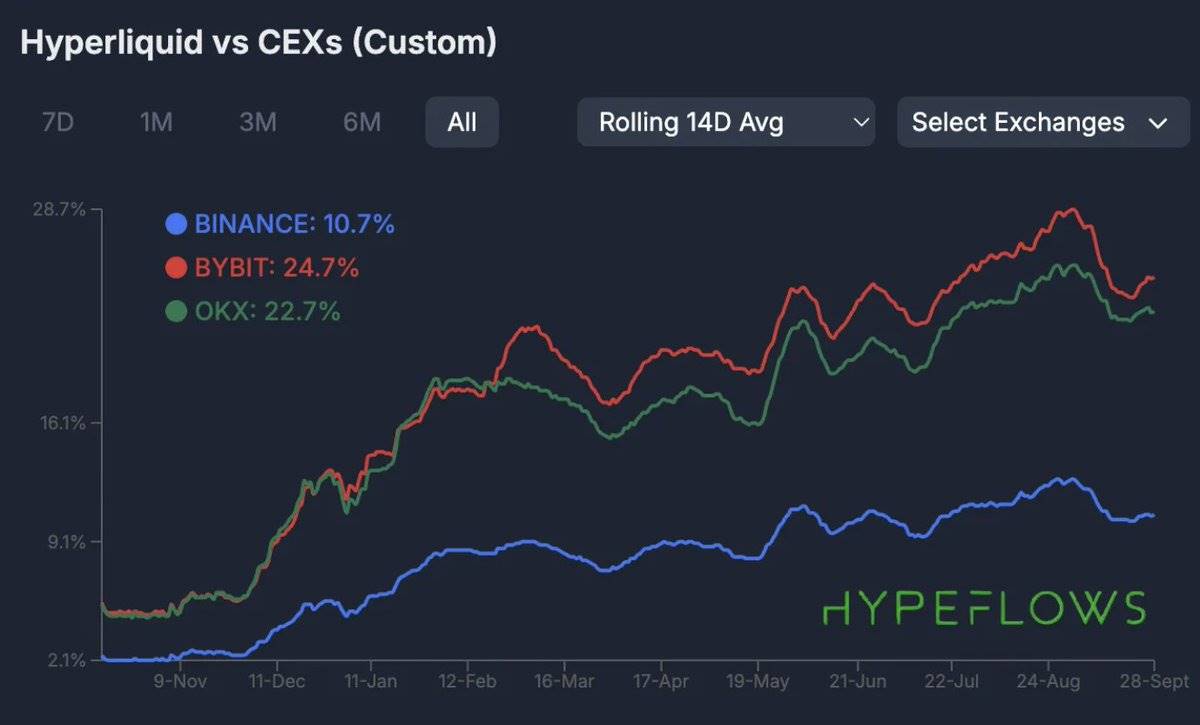
Hyperliquid Trading Volume vs CEX 14-Day Rolling Average (Source: Hypeflows.com)
In terms of perpetual market share, compared to centralized exchange competitors, Hyperliquid currently accounts for 10.7% of Binance’s, 24.7% of ByBit’s, and 22.7% of OKX’s trading volume (based on 14-day rolling averages). Globally, Hyperliquid holds a 5.1% market share in trading volume.
For all exchanges, an important metric is Open Interest, i.e., the total number of contracts currently held open. This indicates strong trader stickiness to the platform, using it as their main trading venue due to performance, deep liquidity, and other factors. In 2025, Hyperliquid’s open interest grew from $3.19 billion to $15.3 billion, an increase of +479%. Currently, Hyperliquid accounts for 5.3% of open interest across all crypto exchanges.
Fee Structure
Hyperliquid’s fee structure includes a 0.45% taker fee and a 0.015% maker fee, with fees adjusted across different tiers based on 14-day weighted trading volume thresholds. The taker fee can be reduced to 0.024%, and the maker fee can go down to 0%, incentivizing market makers to provide deep liquidity to HyperCore’s order book.
Additionally, Hyperliquid’s fee structure is linked to traders who hold and stake HYPE, offering a 5%-40% fee discount based on staking levels, with staking balances ranging from 10k to 500k HYPE.
On average, Hyperliquid’s revenue accounts for 0.0258% of trading volume, remaining stable.
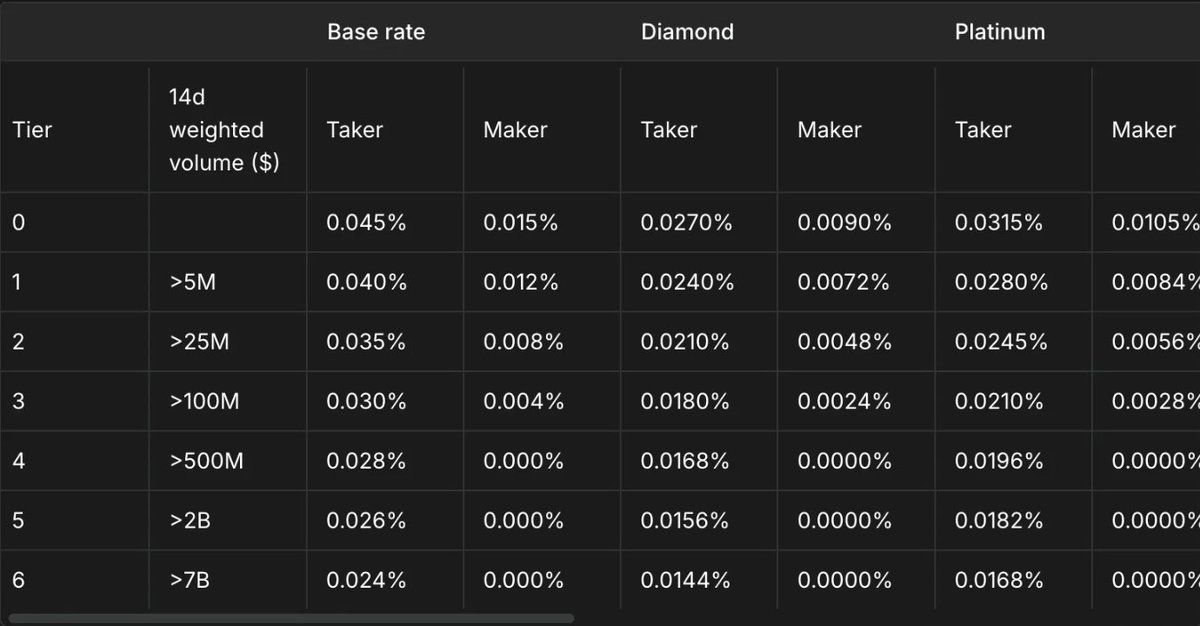
Hyperliquid Taker and Maker Fee Structure
Hyperliquid Assistance Fund (AF)
The Hyperliquid Assistance Fund (AF) is a programmatic execution engine used to buy back HYPE tokens on the secondary market, directing 99% of Hyperliquid protocol-generated revenue to the fund. Revenue from taker fees, maker fees, spot trading fees, liquidation fees, and HIP-1 token listing fees is almost entirely redistributed to the AF.
To date, the AF has repurchased 32.2 million HYPE tokens on the secondary market, with a cumulative investment of $692 million. The current market value is $1.48 billion, with a total book profit (PnL) of $788 million, marking an unrealized return rate of +113%. The HYPE tokens held by the AF account for 9.56% of the circulating supply.
In 2024, Robinhood’s net income was $2.95 billion (according to its Q4 disclosures), and it repurchased $257 million worth of HOOD stock, accounting for 8.7% of its annual net income. Even taking Apple, the company with the highest buyback ratio among the MAG7, as an example, it repurchased $95 billion worth of stock in 2024, accounting for 24.3% of its annual net income.
We cite these figures to illustrate two points: First, Hyperliquid’s value is not diluted; second, even compared to traditional stock markets, its buyback structure is unique in both the digital asset space and traditional equity markets.
In a short period, Hyperliquid has become the highest-earning Layer-1 protocol, with its growth driven by strong demand for superior decentralized trading products. Below is the continuous growth trend of Hyperliquid protocol’s quarterly and monthly revenue:

Hyperliquid Monthly and Quarterly Revenue
Hyperliquid has not only become the highest-earning protocol in the digital asset space but also allocates almost all protocol revenue to accumulate its own tokens on HyperCore.

Network Revenue of All Major Public Chains (Source: blockworks.com)
HyperUnit Spot Market
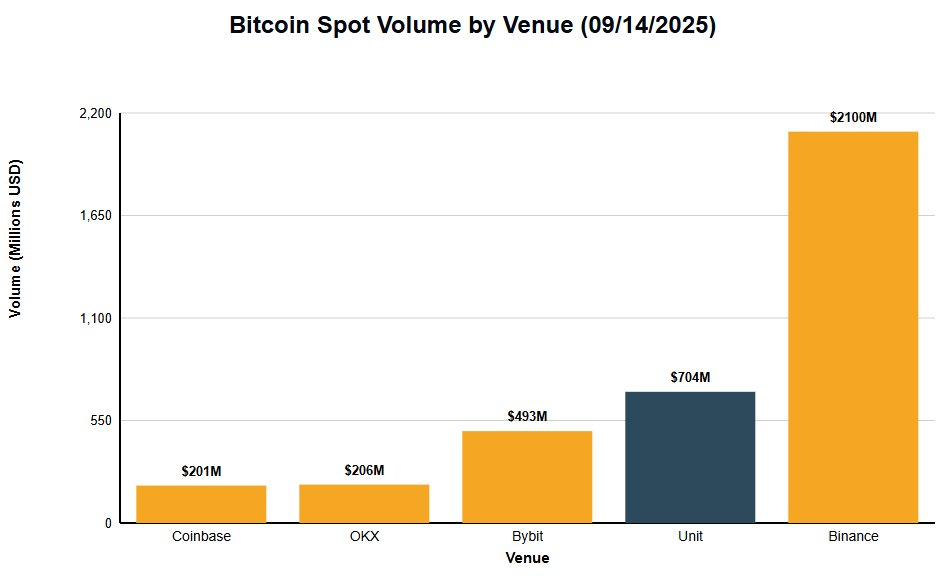
On September 14, 2025, HyperCore ranked second in Bitcoin spot trading volume among major centralized exchanges (CEX).
HyperUnit is an asset tokenization and cross-chain bridging layer that enables seamless spot trading of native assets (such as BTC, ETH, and SOL) on the HyperCore order book. Assets bridged through HyperUnit are converted into u-assets, which can be traded on HyperCore’s order book or used in the emerging HyperEVM ecosystem, such as money market protocols like Felix.
Assets are sent to a HyperUnit address on the native chain, then locked, and a corresponding u-token is minted on Hyperliquid at a 1:1 ratio. This allows native spot assets to be 1:1 backed on both HyperCore and HyperEVM.
As a case study to demonstrate how HyperUnit and HyperCore’s trading engine efficiently support spot assets, from August 20 to 25, 2025, a Bitcoin whale deposited 22,769 BTC (worth $2.59 billion) to Hyperliquid via HyperUnit and converted UBTC into 472,920 UETH (worth $2.22 billion). This is one of the most significant public asset conversions to date, achieved seamlessly and permissionlessly through HyperCore’s spot market.
To date, HyperUnit has processed $718 million in asset deposits, covering BTC, ETH, SOL, and FARTCOIN, providing a fully permissionless, high-performance order book trading method for spot assets. Since its inception, the HyperUnit spot market has executed $4.05 billion in spot trading volume, with Bitcoin spot trading on Hyperliquid reaching $2.14 billion.
Additionally, HyperUnit has successfully provided first-day trading opportunities for several major Token Generation Events (TGEs), with recent examples including PUMP and XPL. We expect this trend to continue, with spot order book trading volume further increasing as asset deposits grow and new high-profile projects launch on TGE day.
Builder Codes: Hyperliquid’s Liquidity and Distribution Flywheel
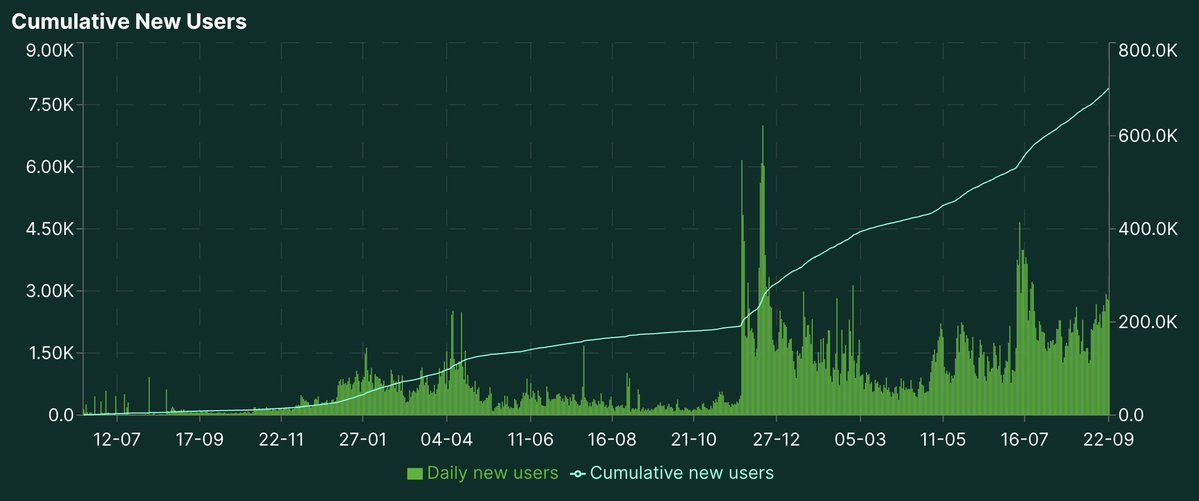
HyperCore Daily and Cumulative New Users
Builder Codes are one of the most important components of the Hyperliquid protocol, opening distribution channels for new users and allowing third parties to connect directly to HyperCore’s high-performance trading engine and liquidity. Third-party applications are responsible for building the frontend and leveraging HyperCore as the direct backend to provide native perpetual contract trading services to their user base. To date, Builder Codes have generated over $30 million in revenue and attracted 169,900 new wallets to interact with HyperCore.
Paxos Labs explicitly stated in its recent USDH proposal that Hyperliquid will serve as the default liquidity infrastructure, providing seamless and efficient spot and perpetual trading. Based on Paxos’s USDH proposal, we believe the next phase of Builder Codes’ growth will come from direct integration with FinTechs and brokerage platforms. Builder Codes have already achieved significant success with crypto-native wallet providers (such as Phantom) and other crypto-native integrations (such as Axiom and BasedApp). Given that FinTechs or prime brokers currently do not offer perpetual trading to their users, this provides these platforms with a convenient way to offer perpetual trading to their large, well-funded user bases without building backend infrastructure or bootstrapping liquidity.
For companies with crypto-native user bases or larger players (such as FinTechs), it is hard to refuse such an easy way to integrate a new revenue line that not only benefits users but also increases platform revenue. For example, Phantom generated $18.8 million in revenue in Q3 alone through this integration. We expect several large FinTechs and brokerage platforms to directly integrate Builder Codes into their platforms, potentially attracting millions of new users to Hyperliquid and significantly increasing trading volume. Given that Interactive Brokers is exploring stablecoin deposits, we believe its 3.3 million clients may access perpetual trading through Hyperliquid’s Builder Codes in the future. Other strong integration candidates include FinTech company Revolut, which has 65 million customers.
Builder Codes 2026 Growth Analysis
Assuming a builder fee of 0.05%, Builder Codes brought $20 billion in trading volume to Hyperliquid in September. It quickly became a major source of trading volume for the Hyperliquid protocol, accounting for 7.1% of total perpetual contract trading volume in September alone:
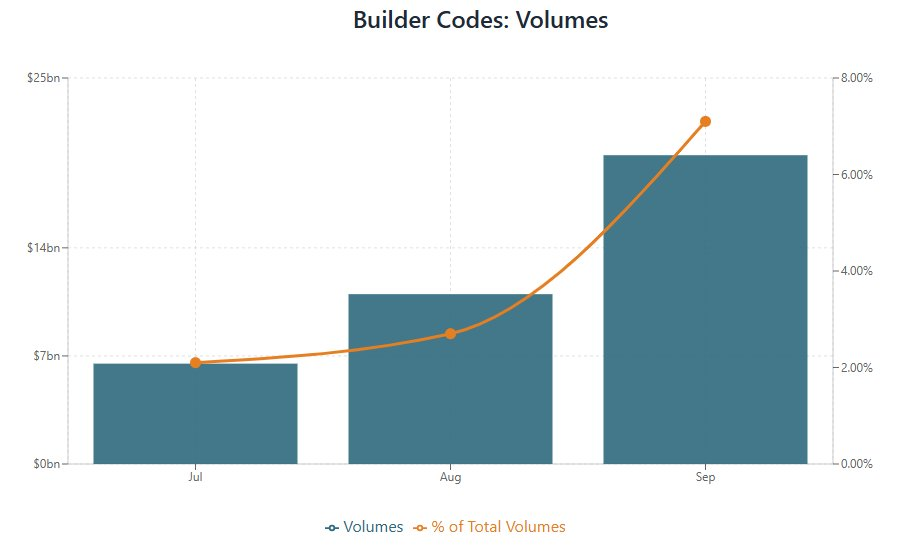
Builder Codes Monthly Trading Volume and Percentage of Total Perpetual Trading Volume
We conducted scenario analysis on the impact of Builder Codes on Hyperliquid’s revenue. Assuming average revenue per unit trading volume is 0.026%, and setting a baseline scenario of 10 major Builder Code integrations by the end of 2026, each with an average monthly trading volume of $5 billion, we expect these integrations to bring $154 million in annualized revenue to Hyperliquid by the end of 2026:
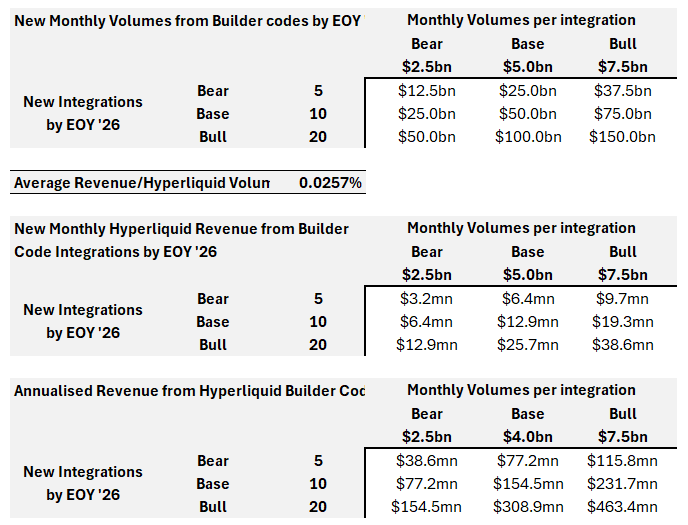
2026 Builder Codes Model Analysis
This would represent a 15.6% increase in Hyperliquid’s revenue—excluding any organic growth of Hyperliquid’s perpetual contract exchange and overall perpetual market growth.
Hyperliquid Steps into the Stablecoin Boom
USDH: Hyperliquid Native Stablecoin
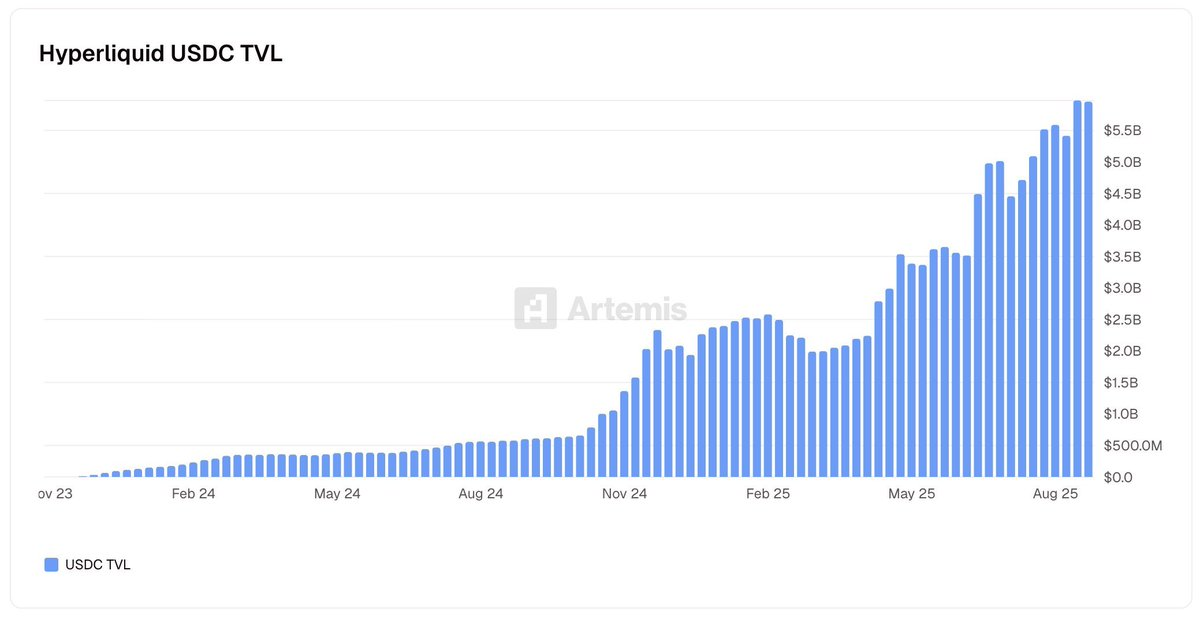
Total USDC Bridged to HyperCore
Hyperliquid recently entered the upcoming stablecoin boom with its native stablecoin USDH. USDH is a fiat-backed native stablecoin used as a quote and collateral asset on HyperCore.
To date, well-known stablecoin issuers like Circle and Tether have benefited most from treasury yield supporting USDC/USDT. USDH aims to change this status quo, returning 50% of USDH-generated yield to the Assistance Fund for secondary market HYPE buybacks.
USDH has received multiple proposals from well-known institutional players, including Paxos/PayPal, Agora, Ethena, BitGo, and Native Markets. These proposals detail their respective custodians, treasury yield distribution, compliance with the newly passed GENIUS Act, and proposed partnerships. The proposal from Native Markets has been approved through Hyperliquid’s governance mechanism.
Currently, Hyperliquid holds about $5.6 billion in Circle USDC on HyperCore, which mainly benefits Circle and Coinbase, not the Hyperliquid ecosystem. Based on the deposited USDC and the Fed’s recent dot plot forward guidance (expecting a 75bps rate cut by the end of 2025), assuming 100% conversion to USDH, this would bring $98 million in annual revenue to the protocol for HYPE buybacks.
For USDH, Circle recently launched native USDC and CCTP V2 on HyperEVM, began buying HYPE on the secondary market, and is seeking to become a validator. This move is significant as it demonstrates full alignment between Circle and Hyperliquid, facilitating complete institutional capital inflow and outflow channels through Circle Mint and launching HyperEVM’s DeFi protocols, especially emerging money market protocols. Plans include seamless deposit and withdrawal functionality between HyperEVM and HyperCore via CCTP V2, covering 14 other blockchains.
Although some well-known proposals failed to obtain USDH code, many will continue and deploy stablecoins with different codes. Ultimately, this means Hyperliquid will host multiple fiat-backed stablecoins and several stablecoins aligned with its ecosystem, all with mature capital inflow and outflow channels and enterprise-grade rails. We expect major payment providers like PayPal and Venmo to make progress in the emerging Hyperliquid stablecoin ecosystem through direct capital inflow and outflow channel integration, potentially opening the door to PayPal’s 400 million users and 35 million merchants.
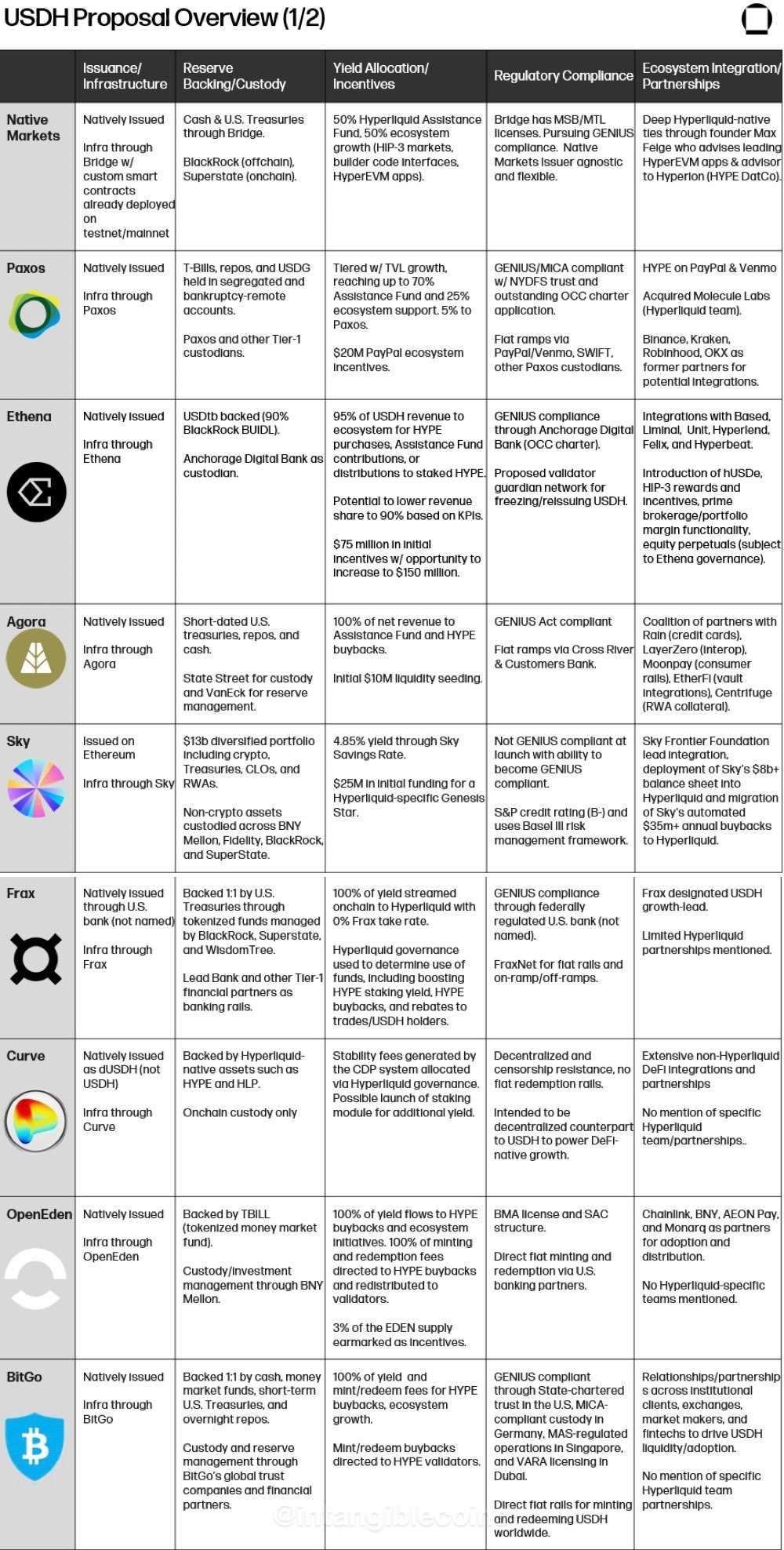
USDH Proposals (Galaxy Research)
Hyperliquid-Aligned Stablecoins
The Hyperliquid Foundation announced a new stablecoin-focused proposal to provide a permissionless primitive for stablecoin issuers.
This primitive offers stablecoin issuers 20% lower trader fees, 50% better market maker fees, and a 20% increase in trading volume contribution when used as a quote asset for spot trading pairs or as collateral for HIP-3 deployed markets on HyperCore.
The above measures further accelerate Hyperliquid’s liquidity flywheel, incentivizing liquidity provision and trading volume growth, while driving USDC conversion to USDH and further generating revenue from aligned stablecoins.
To become an aligned stablecoin on Hyperliquid, issuers must enable permissionless quote assets, with deployers staking 800,000 HYPE and quote token deployment requiring 200,000 HYPE, totaling 1 million HYPE staked to receive the above benefits. Additionally, 50% of off-chain yield must be shared with the protocol, going directly to the Assistance Fund for HYPE secondary market buybacks.
The aligned stablecoin proposal aims to lay the foundation for Hyperliquid to become the settlement layer for next-generation payments and personal financial technology. Carrying all finance means fully entering the upcoming stablecoin race. As quoted in the Hyperliquid announcement, “The blockchain that carries the future of finance should also be the premier stablecoin chain.”
Similar to Builder Codes, we conducted scenario analysis to speculate on the possible state of the Hyperliquid stablecoin market by the end of 2026. Stablecoin deposits on the Hyperliquid chain have expanded significantly—from $2 billion at the beginning of the year to $5.9 billion by the end of Q3, achieving a 314% annualized growth rate, compared to 64% for the overall stablecoin market.

Hyperliquid 2025 USDC Growth Rate (Jan–Sep 2025)
Hyperliquid achieved significant USDC growth in 2025, with a very prominent growth rate from January to September. However, as Hyperliquid reaches scale this year, growth in 2026 is expected to slow. As a base forecast, we assume a 150% USDC growth rate by the end of 2026 (EOY '26).
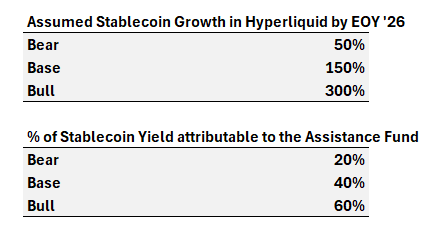
Hyperliquid USDC Growth Rate to End of 2026
Crucially, we expect USDC’s dominance to shift significantly to Hyperliquid-aligned stablecoins as the above USDH proposals are implemented. Assuming the latest FedWatch probabilities, treasury yields fall to 3%, and per the USDH proposal, 50% of stablecoin-backed yield flows to the Assistance Fund, we expect the protocol to generate an additional $110 million in annual revenue by the end of 2026:
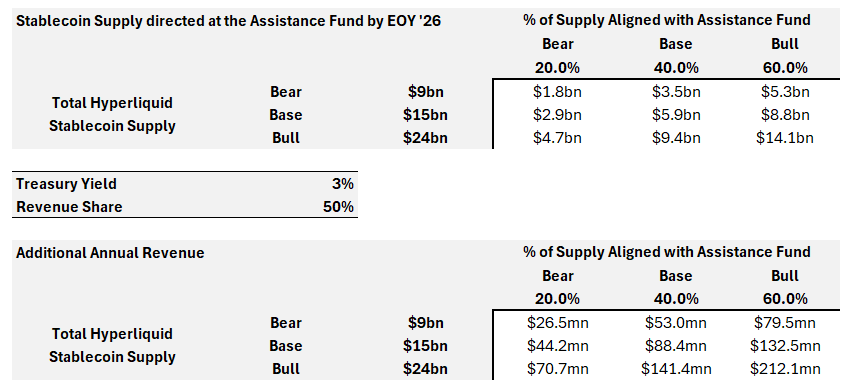
2026 Aligned Stablecoin Model Analysis
HIP-3: Builder-Deployed Perpetual Markets
HIP-3 is a new Hyperliquid Improvement Proposal aimed at transforming the exchange’s perpetual contract listing into an on-chain primitive, eliminating the validator-approved listing process. This change allows anyone to permissionlessly create their own native perpetual market on HyperCore.
With HIP-3, each market has its own order book, and new market deployments on HyperCore are conducted through a Dutch auction process every 31 hours, with an estimated 282 new markets deployed annually. To deploy an order book on HyperCore via Dutch auction, each entity must stake 500,000 HYPE.
HIP-3 offers maximum flexibility for deployers, allowing full customization of markets, including Oracle integration, specifying collateral assets, setting fee parameters, and adding extra deployer fees on top of base fees.
HIP-3 opens HyperCore to traditional markets such as indices, stocks, forex, commodities, bonds, and other non-traditional markets like political prediction and pre-IPO markets.
We are moving toward a digital era where people prefer to hold digital dollars. There is considerable friction between capital inflow/outflow channels and transfers to brokerage accounts. Additionally, traders are accustomed to trading perpetual contracts, as they are the easiest derivative for end users to understand and express market views. Hyperliquid’s goal is to carry all finance, and this statement should be taken literally: any market with an available Oracle will be tradable on HyperCore.
Given that HIP-3 is not yet live, it is currently difficult to record the potential trading volume these markets could achieve. We have already seen several excellent teams announce they will launch perpetual markets via HIP-3, including:
-
Kinetiq’s Launch: Kinetiq is the leading liquid staking protocol on Hyperliquid and announced Launch in July, a HIP-3-based “exchange-as-a-service” infrastructure product to help teams deploy new perpetual markets.
-
Ventuals: On October 6, Ventuals announced they would launch a perpetual exchange with 10x leverage for pre-IPO companies via HIP-3.
-
HyperUnit’s trade.xyz: As mentioned earlier, HyperUnit is a key component of the Hyperliquid ecosystem, facilitating spot trading activity on HyperEVM. They shared news about trade.xyz, which is speculated to be their HIP-3-launched perpetual decentralized exchange.
These teams will immediately create new perpetual market activity, contributing to Hyperliquid’s economic system. HIP-3 market fees can be up to 2x—Hyperliquid charges the same fee on HIP-3 trading volume, while deployers can receive up to 50% of the fees. Thus, HIP-3 is an expansion mechanism for Hyperliquid without compromising its unit economics.
Given that HIP-3 supports the creation of new perpetual markets, we believe its impact could be greater than Builder Codes, which only provide further access to current perpetual markets on HyperCore. HIP-3 perpetual instances will support crypto assets, but more importantly, may expand to commodities, stocks and indices, and pre-IPO/non-traditional markets. As a baseline scenario, we believe 15 strong HIP-3 perpetual integrations will go live by the end of 2026, bringing over $40 billion in monthly trading volume to the protocol:
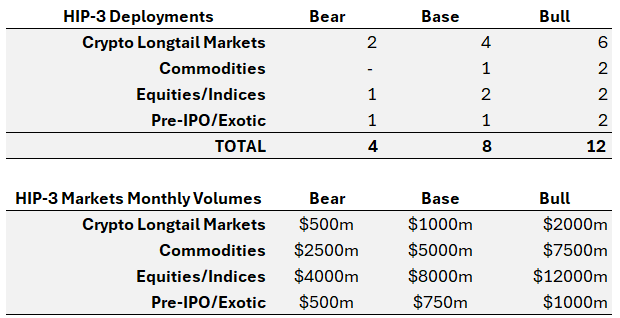
Assuming a fee rate of 0.0225%, this would bring an additional $120 million in annualized revenue as a baseline scenario:
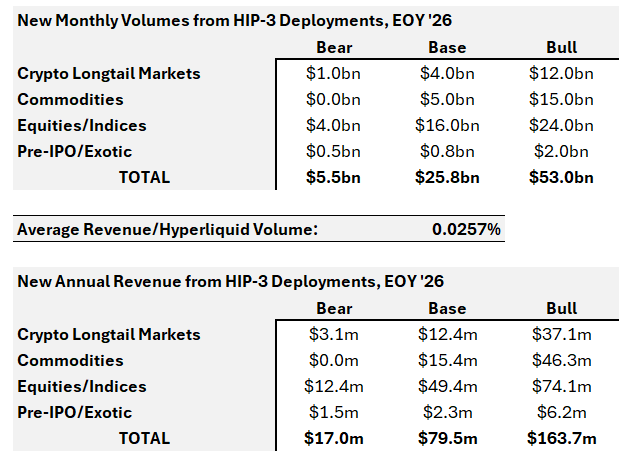
HIP-4: Event Markets and Parlays
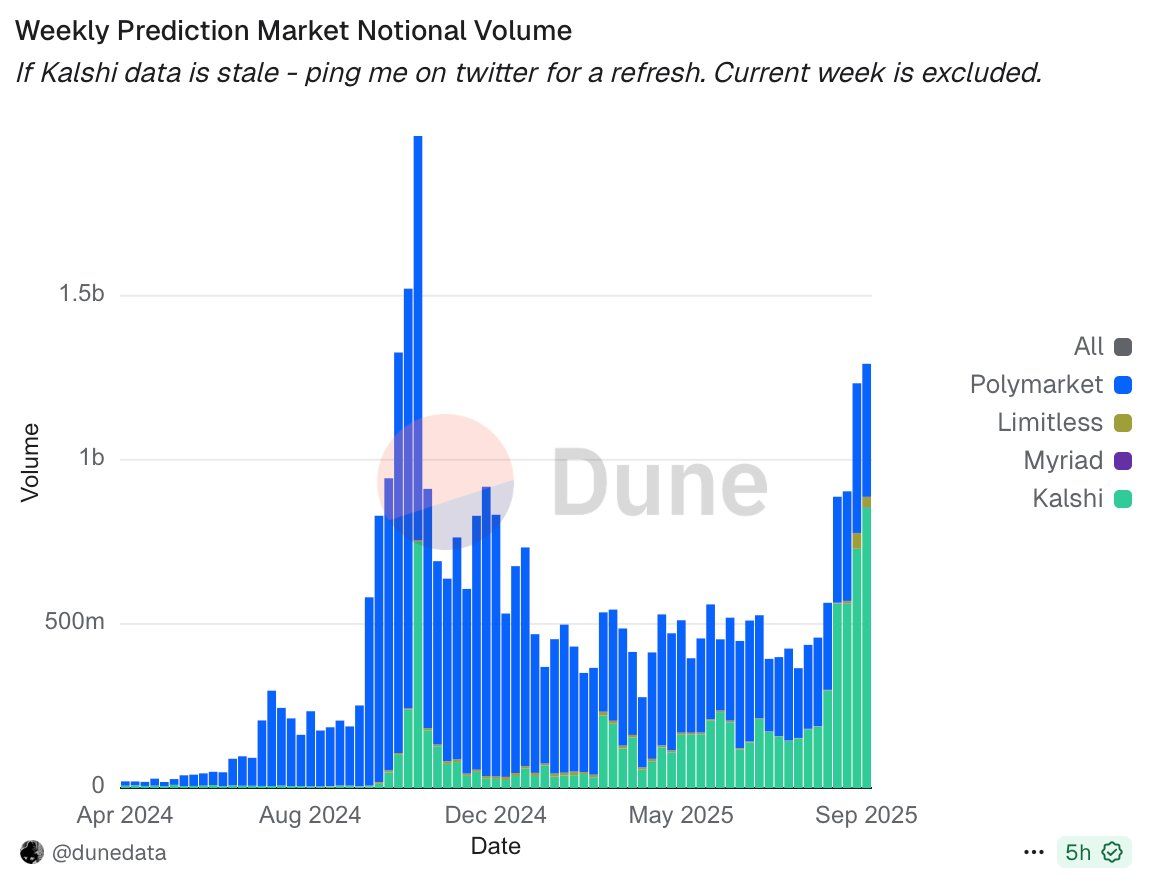
Weekly Prediction Market Trading Volume (Polymarket and Kalshi)
HIP-4 is a brand new Hyperliquid protocol improvement proposal aimed at introducing binary markets similar to prediction markets, such as Kalshi and Polymarket, both of which have driven significant adoption mainly through political prediction.
Prediction markets like Kalshi and Polymarket attract a lot of attention, with notional trading volume exceeding $11 billion weekly and cumulative trading volumes of $8.2 billion and $27.9 billion, respectively.
Although HIP-3 introduces builder-deployed perpetual order books, it does not support prediction markets in their current form, as the mark price can only change by 1% per move, making it impossible to support binary payout structures.
In response to the Hyperliquid team, Jeff has commented on event perpetual contracts, stating they are better viewed as permissionless spot deployments, fully collateralized with no liquidation or ongoing funding fees.
HIP-4 also opens the possibility for introducing parlays. Parlays are multiple independent single bets, commonly used in sports betting, providing convexity without leverage.
In summary, HIP-4 aims to redefine how markets are deployed on Hyperliquid and paves the way for Hyperliquid to enter the emerging prediction market trend, with the potential to compete with rivals like Polymarket and Kalshi.
Hyperliquid Digital Asset Trusts
Like many other well-known protocols, Hyperliquid is well positioned to capture the emerging wave of digital asset trusts (DATs), which aim to acquire underlying assets to hold on their balance sheets. Through Nasdaq-listed stocks, accredited investors will be able to gain exposure to HYPE without self-custody. As we know, HYPE is poorly distributed on centralized exchanges (CEX), currently limiting its accessibility, especially for US users. Digital Asset Trusts (DATs) like Hyperliquid Strategies Inc. plan to address this accessibility issue by the end of 2025.
Hyperliquid Strategies Inc (Nasdaq: PURR)
Hyperliquid Strategies Inc is a newly established trust company focused on acquiring HYPE, formed from the business combination of Sonnet BioTherapeutics and Rorscach I LLC. The new ticker HSI will be listed on Nasdaq.
HSI is led by Bob Diamond, founding partner of Atlas Merchant Capital, former CEO of Barclays, and former senior executive at Credit Suisse and Morgan Stanley. Also involved is David Schamis, Chief Investment Officer at Atlas Merchant Capital and former Managing Director at J.C. Flowers.
Upon completion of the transaction, Hyperliquid Strategies Inc is expected to hold about 12.6 million HYPE tokens (worth $578 million) and at least $305 million in cash investments. HSI expects to complete the transaction in Q4 2025.
Participants include well-known institutions such as Paradigm, Galaxy Digital, Pantera, and D1 Capital.
On September 4, 2025, HSI filed an S-4 with the US Securities and Exchange Commission (SEC), formalizing the merger for shareholders.
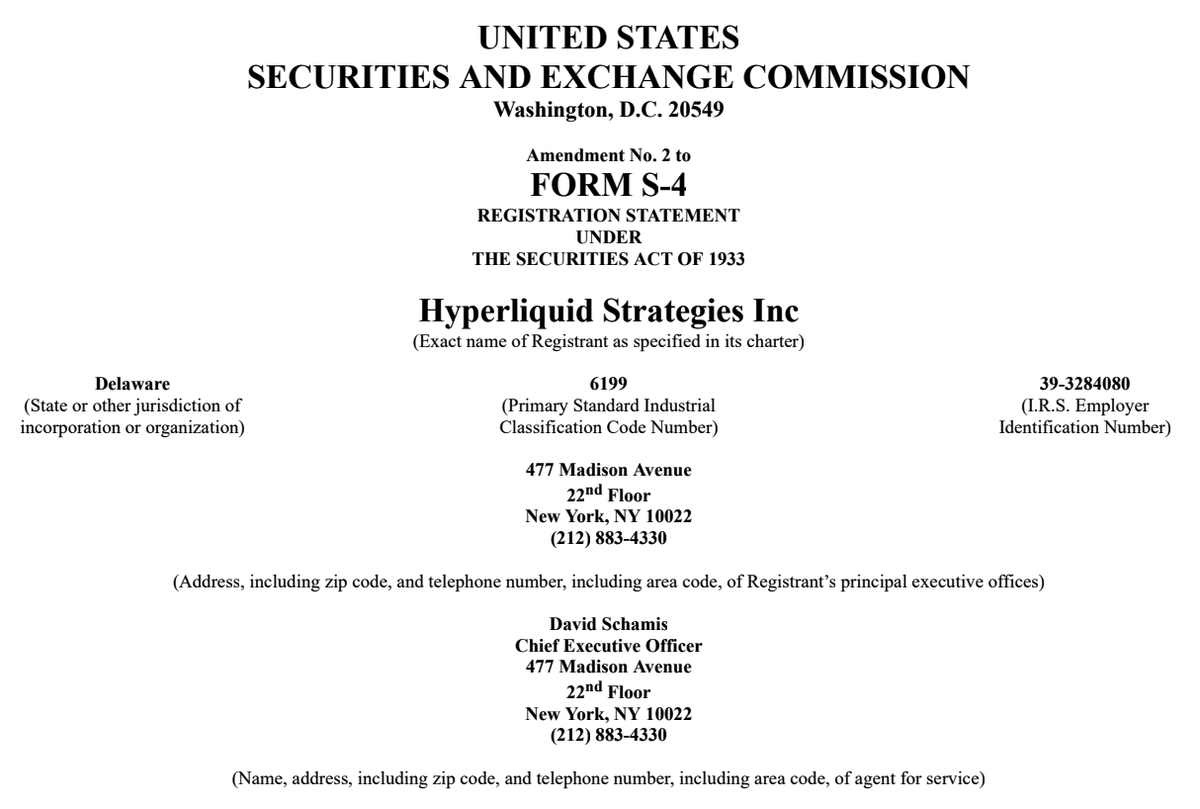
Hyperliquid Strategies Inc S4 Filing
Hyperion DeFi (Nasdaq: HYPD)
Hyperion DeFi is the rebranded entity of Eyenovia Inc, with a core focus on acquiring HYPE through HyperEVM and staking/yield generation strategies.
According to a news brief on September 25, Hyperion DeFi holds 1.71 million HYPE at an average purchase price of $38.25.
Sonnet and Hyperion DeFi now hold a total of 18.43 million HYPE, worth $834 million, permanently removed from circulating supply.

HYPE Holdings of Hyperliquid Strategies Inc and Hyperion DeFi
Core Contributor Unlock Plan
Hyperliquid core contributors’ accounts hold 238 million HYPE tokens, accounting for 23.8% of total supply. These tokens will begin unlocking monthly after November 29, 2025.
We believe it is unreasonable to assume that 23.8% of token supply will be fully allocated to 11 team members. Tokens allocated to core contributors after the genesis event will be locked for one year and will vest between 2027 and 2028. In some cases, vesting may even extend beyond 2028. We believe this indicates that supply after 2028 may be allocated to future core contributors and could account for 3%-6% of the core contributor supply.
Hyperliquid core contributors have the right to sell tokens. However, it is also unreasonable to assume they would directly destroy the spot order book from an execution perspective. In reality, there are many ways for core contributor supply to be transferred to large entities seeking additional HYPE exposure, which would be simple ownership transfers without directly impacting the spot order book.
We are not saying core contributors will never sell directly on the spot order book, but we emphasize there are many other ways to complete supply transfers without causing direct sell pressure. We note that some infer sell pressure from monthly unlocks, but we believe this concern is exaggerated. The Hyperliquid team has demonstrated complete alignment from day one and has never deviated in any way.
Robinhood founder Vlad Tenev sold 3.8 million shares of Robinhood Class A stock and holds 50.2 million unconverted Class B shares, while Robinhood’s market cap reached $111.2 billion. We draw this analogy because we believe Hyperliquid’s future growth potential is comparable to Robinhood’s.
Given Hyperliquid’s grand long-term vision and the substantial work still to be done, we expect Jeff and other core contributors to maintain the same team alignment. HYPE unlocks and sales will be clearly signaled, and if sold directly on the spot order book, will be executed in batches.
Valuation Framework
In this report, we include multiple scenario analyses to infer the revenue potential of Hyperliquid’s three main growth drivers:
-
Continued expansion of Builder Codes.
-
Launch of Hyperliquid-aligned stablecoins, with a portion of revenue allocated to the Assistance Fund.
-
Launch of HIP-3 markets, expected to achieve over $40 billion in monthly trading volume by the end of 2026.
In addition, we believe Hyperliquid’s core perpetual contract exchange will continue to achieve organic growth. Decentralized perpetual contract exchanges are significantly capturing market share from centralized exchanges (CEXs), and this trend is very clear: in the first three quarters of 2025, decentralized perpetual contract exchanges saw a 125% year-on-year increase in trading volume.
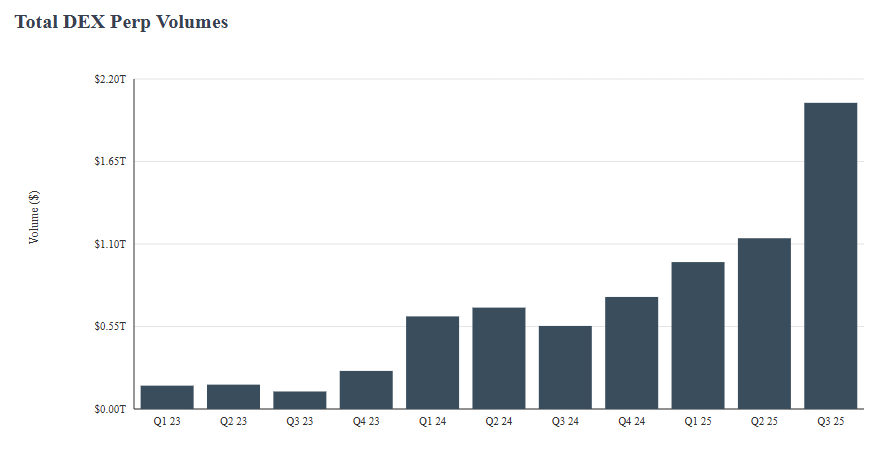
We expect this trend to continue. Despite many competitors emerging in recent weeks, we believe Hyperliquid will maintain a 40% market share in perpetual contract activity. Below is a scenario analysis of total decentralized perpetual contract exchange trading volume growth by the end of 2026 and our expectations for Hyperliquid’s market share. These forecasts are based on the platform’s organic growth, excluding HIP-3 and Builder Code trading volume:
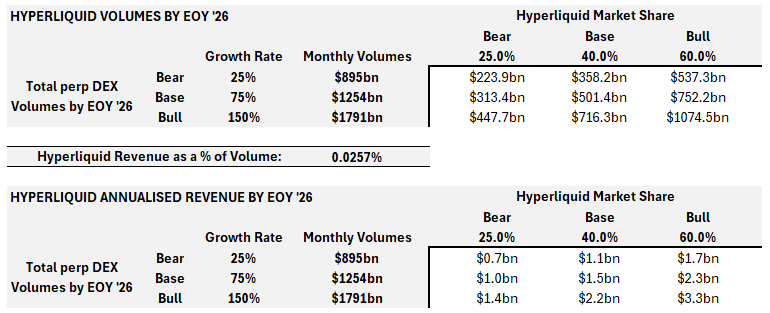
Taking all the above into account, we believe the base case is that Hyperliquid’s annualized revenue will reach $1.9 billion by the end of 2026, representing a 70% increase over annualized revenue in Q3 2025.
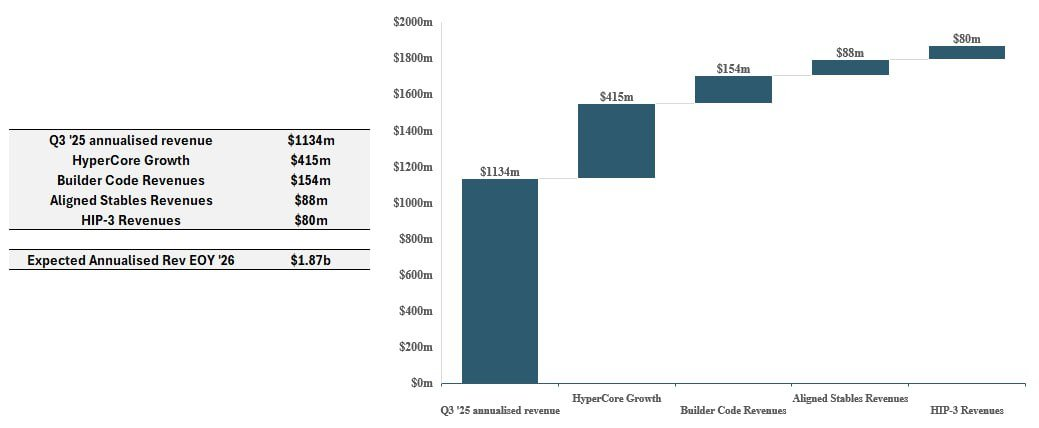
Hyperliquid Q3 2025 Annualized Revenue and Core Contributor Floating Growth One-Year Analysis
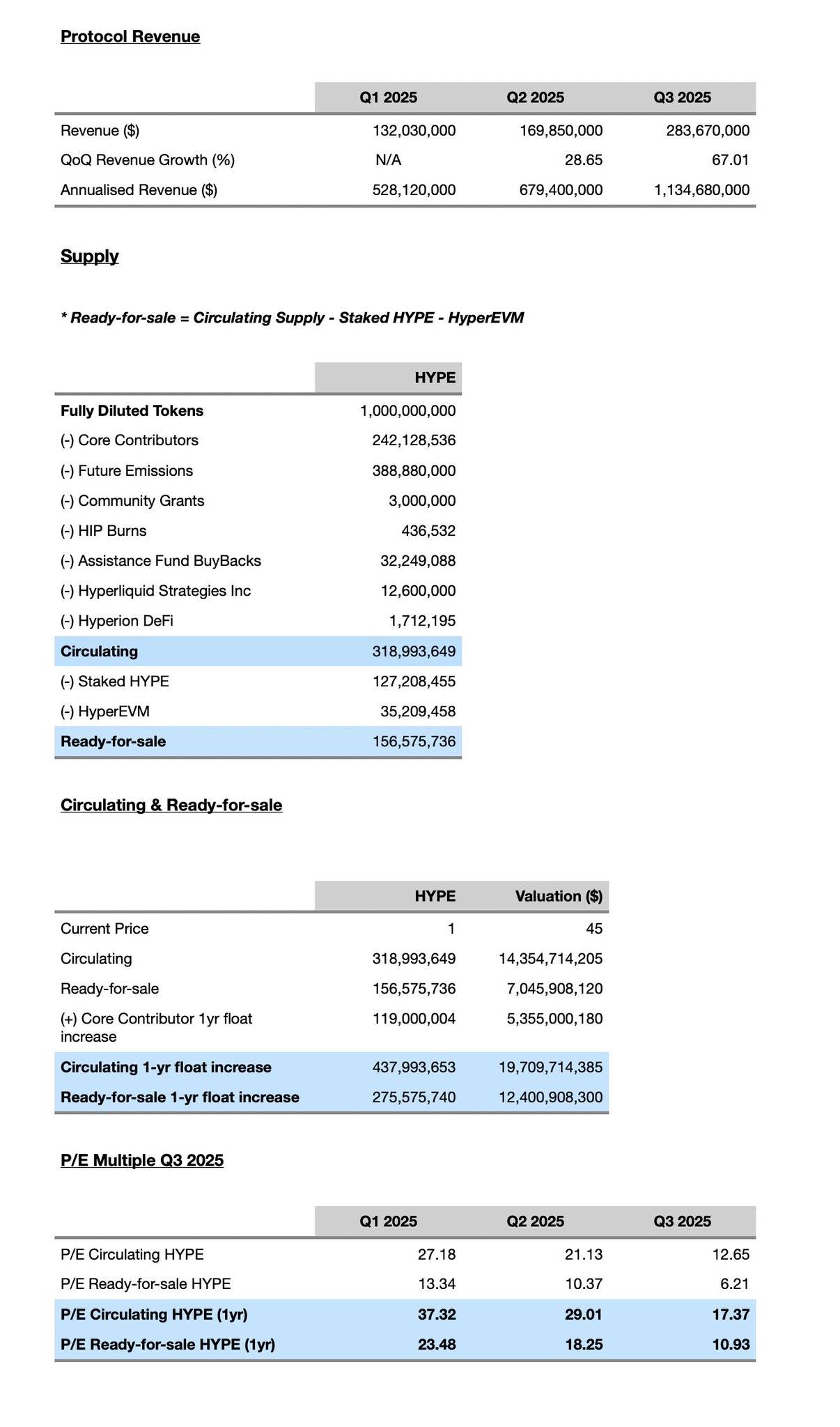
Hyperliquid 2026 Revenue Forecast and Core Contributor Floating Growth One-Year Analysis
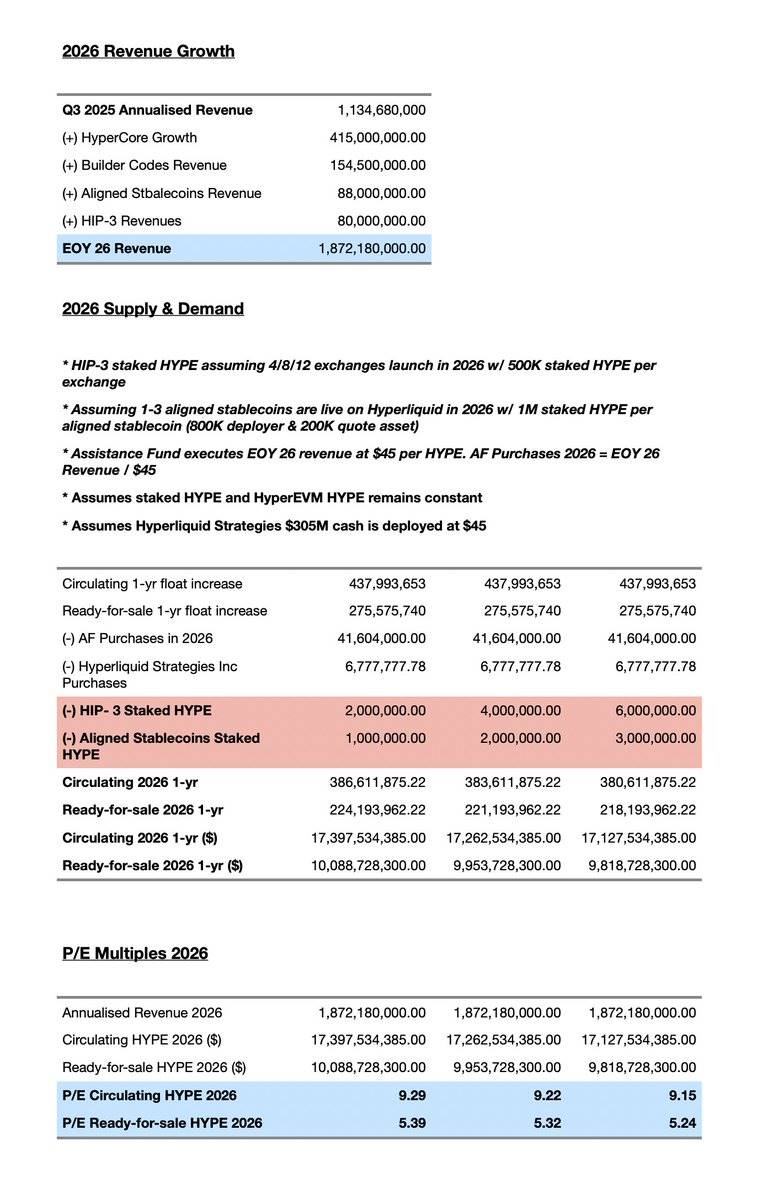
2026 Forecast
-
Hyperliquid will continue to eat into centralized exchange (CEX) perpetual trading market share, a trend driven by the liquidity flywheel and further accelerated by Builder Codes’ traffic. We predict that by the end of 2026, Hyperliquid will account for 15%-25% of Binance’s perpetual trading market share and 7.5%-15% of the global perpetual trading market.
-
Major FinTechs and brokers will begin offering perpetual trading services to users through direct integration of Builder Codes. These integrations will significantly boost protocol revenue.
-
Hyperliquid will launch multiple fiat-pegged stablecoins, driving 50% of treasury yield back to the Assistance Fund. Additionally, we expect many institutions involved in the USDH proposal to advance plans to launch fiat-pegged stablecoins on Hyperliquid. By the end of 2026, we expect USDH issuance to exceed $5 billion, with other Hyperliquid-aligned stablecoins totaling over $2 billion in issuance.
-
HIP-3 will support multiple active perpetual markets, with key trading targets including indices, stocks, forex, and commodities. Most deployed HIP-3 markets will use USDH as the quote asset, further cementing USDH’s position and driving USDC-to-USDH migration on HyperCore.
-
Hyperliquid will expand into the Real World Asset (RWA) sector, allowing 1:1-backed tokenized stocks to be traded on the spot order book. This will go beyond trading traditional markets via HIP-3 perpetuals, making it the deepest on-chain access point for traditional market liquidity.
-
DATs (Dynamic Asset Trusts) centered on Hyperliquid will perform exceptionally well, naturally driving HYPE’s value growth. We also expect many other DATs to be announced and launched in 2026, with differentiated strategies, especially focused on HIP-3 and HyperEVM.
-
Multiple Hyperliquid spot ETFs may be filed in 2026 to improve accessibility for qualified investors. Given that Hyperliquid is the highest-earning protocol in the digital asset space, we expect it to attract significant institutional interest. By then, Hyperliquid’s annual revenue could exceed $2 billion.
Conclusion
We believe that as institutions gradually embrace digital assets as an asset class, public markets are entering a prime period for growth investing. Previous market cycles have left a deep psychological impact on participants, and we are approaching a turning point where several key businesses are beginning to scale, generate substantial cash flow, attract top talent, and expand consumer-facing product offerings. Against this backdrop, investing in top teams with outstanding execution and accompanying their growth stories over the next few years is our core philosophy.
Arete Capital’s liquidity investment approach is not active public market trading, but rather seeking a handful of extraordinary investment opportunities with deep value and achieving investment returns from a long-term perspective. Hyperliquid remains our core liquidity investment choice, perfectly embodying our growth investing approach within the above philosophy. With the arrival of HIP-3, bringing traditional markets on-chain via perpetual contracts, and its role in the stablecoin growth story (such as USDH), we can clearly see that important parts of the financial system are being introduced into HyperCore and HyperEVM. The grand vision of unifying the entire financial sector on Hyperliquid has never been clearer.



